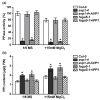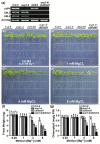Vacuolar Proton Pyrophosphatase Is Required for High Magnesium Tolerance in Arabidopsis
- PMID: 30453498
- PMCID: PMC6274811
- DOI: 10.3390/ijms19113617
Vacuolar Proton Pyrophosphatase Is Required for High Magnesium Tolerance in Arabidopsis
Abstract
Magnesium (Mg2+) is an essential nutrient in all organisms. However, high levels of Mg2+ in the environment are toxic to plants. In this study, we identified the vacuolar-type H⁺-pyrophosphatase, AVP1, as a critical enzyme for optimal plant growth under high-Mg conditions. The Arabidopsis avp1 mutants displayed severe growth retardation, as compared to the wild-type plants upon excessive Mg2+. Unexpectedly, the avp1 mutant plants retained similar Mg content to wild-type plants under either normal or high Mg conditions, suggesting that AVP1 may not directly contribute to Mg2+ homeostasis in plant cells. Further analyses confirmed that the avp1 mutant plants contained a higher pyrophosphate (PPi) content than wild type, coupled with impaired vacuolar H⁺-pyrophosphatase activity. Interestingly, expression of the Saccharomyces cerevisiae cytosolic inorganic pyrophosphatase1 gene IPP1, which facilitates PPi hydrolysis but not proton translocation into vacuole, rescued the growth defects of avp1 mutants under high-Mg conditions. These results provide evidence that high-Mg sensitivity in avp1 mutants possibly resulted from elevated level of cytosolic PPi. Moreover, genetic analysis indicated that mutation of AVP1 was additive to the defects in mgt6 and cbl2 cbl3 mutants that are previously known to be impaired in Mg2+ homeostasis. Taken together, our results suggest AVP1 is required for cellular PPi homeostasis that in turn contributes to high-Mg tolerance in plant cells.
Keywords: AtAVP1; cellular PPi homeostasis; high-Mg tolerance; vacuolar H+-pyrophosphatase.
Conflict of interest statement
The authors declare no conflict of interest.
Figures






Similar articles
-
Keep an eye on PPi: the vacuolar-type H+-pyrophosphatase regulates postgerminative development in Arabidopsis.Plant Cell. 2011 Aug;23(8):2895-908. doi: 10.1105/tpc.111.085415. Epub 2011 Aug 23. Plant Cell. 2011. PMID: 21862707 Free PMC article.
-
Arabidopsis type I proton-pumping pyrophosphatase expresses strongly in phloem, where it is required for pyrophosphate metabolism and photosynthate partitioning.Plant Physiol. 2015 Apr;167(4):1541-53. doi: 10.1104/pp.114.254342. Epub 2015 Feb 13. Plant Physiol. 2015. PMID: 25681328 Free PMC article.
-
Expression of an Arabidopsis vacuolar H+-pyrophosphatase gene (AVP1) in cotton improves drought- and salt tolerance and increases fibre yield in the field conditions.Plant Biotechnol J. 2011 Jan;9(1):88-99. doi: 10.1111/j.1467-7652.2010.00535.x. Plant Biotechnol J. 2011. PMID: 20492547
-
AVP1: One Protein, Many Roles.Trends Plant Sci. 2017 Feb;22(2):154-162. doi: 10.1016/j.tplants.2016.11.012. Epub 2016 Dec 16. Trends Plant Sci. 2017. PMID: 27989652 Review.
-
Plant proton pumping pyrophosphatase: the potential for its pyrophosphate synthesis activity to modulate plant growth.Plant Biol (Stuttg). 2019 Nov;21(6):989-996. doi: 10.1111/plb.13007. Epub 2019 Jun 5. Plant Biol (Stuttg). 2019. PMID: 31081197 Review.
Cited by
-
Phospholipase Dα1 Acts as a Negative Regulator of High Mg2+-Induced Leaf Senescence in Arabidopsis.Front Plant Sci. 2021 Nov 25;12:770794. doi: 10.3389/fpls.2021.770794. eCollection 2021. Front Plant Sci. 2021. PMID: 34899793 Free PMC article.
-
Elemental profiling and genome-wide association studies reveal genomic variants modulating ionomic composition in Populus trichocarpa leaves.Front Plant Sci. 2024 Nov 28;15:1450646. doi: 10.3389/fpls.2024.1450646. eCollection 2024. Front Plant Sci. 2024. PMID: 39670268 Free PMC article.
-
Mutations in type II Golgi-localized proton pyrophosphatase AVP2;1/VHP2;1 affect pectic polysaccharide rhamnogalacturonan-II and alter root growth under low boron condition in Arabidopsis thaliana.Front Plant Sci. 2023 Aug 17;14:1255486. doi: 10.3389/fpls.2023.1255486. eCollection 2023. Front Plant Sci. 2023. PMID: 37662170 Free PMC article.
-
A Defective Vacuolar Proton Pump Enhances Aluminum Tolerance by Reducing Vacuole Sequestration of Organic Acids.Plant Physiol. 2019 Oct;181(2):743-761. doi: 10.1104/pp.19.00626. Epub 2019 Jul 26. Plant Physiol. 2019. PMID: 31350362 Free PMC article.
References
-
- George G.M., van der Merwe M.J., Nunes-Nesi A., Bauer R., Fernie A.R., Kossmann J., Lloyd J.R. Virus-induced gene silencing of plastidial soluble inorganic pyrophosphatase impairs essential leaf anabolic pathways and reduced drought stress tolerance in Nicotiana benthamiana. Plant Physiol. 2010;154:55–66. doi: 10.1104/pp.110.157776. - DOI - PMC - PubMed
-
- Lόpez-Marqués R.L., Pérez-Castiñeira J.R., Losada M., Serrano A. Differential regulation of soluble and membrane-bound inorganic pyrophosphatases in the photosynthetic bacterium Rhodospirillum rubrum provides insights into pyrophosphate-based stress bioenergetics. J. Bacteriol. 2004;186:5418–5426. doi: 10.1128/JB.186.16.5418-5426.2004. - DOI - PMC - PubMed
MeSH terms
Substances
Grants and funding
LinkOut - more resources
Full Text Sources
Molecular Biology Databases
Miscellaneous

